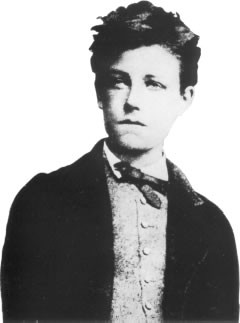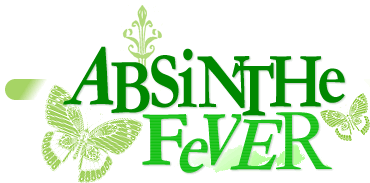
Absinthe and the poet go together like a horse and carriage. The metaphorical Green Fairy first earned her fitting reputation as the artist's muse in the second part of the nineteenth century, when she became the drink of choice among the avante-garde habitues of the Latin Quarter, the artistic district of Paris. It was here, in the absinthe-soaked atmosphere of cafes such as La Nouvelle-Athenes and L'Academie where the Symbolist movement was born. It was under the Fairy's wings where the old was being rejected and the new embraced. It was the Fairy who was the witness to, or perhaps the inspirer of, a profound artistic rebellion.
Arthur Rimbaud -- the original "punk poet", the iconic rebel, and perhaps the most celebrated of all absinthe drinkers -- would certainly agree as to the Fairy's powers as an inspirer, for She was his most faithful companion on his determined quest to express the previously inexpressible.
And how to better introduce Rimbaud's infatuation with the Green Muse than in the words of another poet? Peggy Amond, the contemporary American author, wrote a poem entitled "Rimbaud's Poison" (Copyright 1998):
The emerald hour--
when the poet's pain is soothed
by a liquid jewel
held in the sacred chalice,
upon which rests
the pierced spoon,
the crystal sweetness--
Icy streams trickle down.
The darkest forest
melts into an open meadow
as waves of green seduce.
Sanity surrendered,
the soul spirals toward
the murky depths,
wherein lies
the beautiful madness--
absinthe.
The appearance of young Rimbaud -- he was only 17 at the time -- in Parisian literary circles was met with a bizarre mix of admiration, jealousy, shock and nervous consternation:
"We are witnessing the birth of a genius," declared Leon Valade after attending a dinner of the Vilains Bonshommes, a group of poets to whom Rimbaud was "exhibited" in October 1871. "... a terrifying poet," Valade recalled, "a truly childlike face which might suit a thirteen year old, deep blue eyes, wild rather than timid -- this is the lad whose imagination, with its amazing powers and depravity, has been fascinating or frightening all our friends."
At that very first dinner, Rimbaud gave the astonished poets a taste of his defiant, self-confident nature when he boldly dismissed the alexandrine, the classical meter that had dominated French poetry for over three centuries. "You can imagine how surprised we were by this rebellious outburst," noted Valade. Little did he know what was yet to come.
Soon, Rimbaud developed a reputation as the "savage" of the Latin Quarter, a child rebel who made the avant-garde look prudish. A notorious rule-breaker with a feral disregard, even disgust, for the niceties of Parisian decorum, he outraged decent society and fellow poets alike.
He announced that Paris was "the least intellectual place on Earth", and proposed that the Communards should have blown up Louvre, a symbol of bourgeois tastes. His conversation was sporadic and obscene, his manners non-existent. At poetry readings, he shouted "merde!" and other profanities whenever he disapproved of his fellow poets' works.
Rimbaud's own poetry was, without a doubt, the work of a genius mind ahead of its time. He was the first poet to attempt expressing the inexpressible, in evocative language that bypasses conventional "meaning". He experimented with concepts such as the "colour" of sounds, the impact of sound over sense, and verse libre (free rhythmic patterns). He articulated symbolist ideas before symbolism became a movement; he was "the spectator to the flowering of (his) thought" before the surrealists embraced the notion of the subconscious mind and free-flow thinking; he was a poet-scientist who set down a credible theory for changing human existence itself.
Those familiar with the mind-bending effects of absinthe drinking may be tempted to attribute Rimbaud's ground-breaking visions to the influence of the Green Fairy. Whilst there is no doubt that Rimbaud enjoyed the company of the Fairy, or "absomphe" as he called her, we should remember that absinthe merely inspires genius; it does not create it.
To fully understand Rimbaud's genius, we must realise that he was more of an explorer than a poet. By his own admission, poetry was but his favoured means of exploring the more fundamental aspects of life. Poetry was the medium through which he indulged in the "immense and rational derangement of the senses", a mental adventure that, he hoped, would provide answers to the Unknown.
And if poetry was simply the vehicle that was to take him to his ultimate destination, the Green Fairy was merely a guide along the route, never the driver. Rimbaud didn't drink absinthe to get drunk, he drank it to liberate his mind and enhance his visions. This was in contrast to Paul Verlaine, his fellow poet, and many other artists of the time.
During his short-lived (but brilliant) career as a poet, Rimbaud anarchic lifestyle mirrored his radical artistic life. He was the original room-trasher, the popular occupation of modern-day rock stars: a contemporary recalled how Rimbaud amused himself by smashing "all the porcelain -- water jug, basin and chamber pot," but also "being short of money, he sold the furniture". This apparently happened time and time again.
Unlike those of most modern rock stars, however, Rimbaud's antics were not preconceived publicity stunts, nor were they random acts of anarchy. Just like his poetry, his lifestyle reflected his innermost desire to escape the frightening world of conformity and to re-invent reality.
"Real life is absent," he proclaimed, and "I is somebody else," as well as "Love must be reinvented."
Rimbaud is thought to be the first person of his time to publicly stand up for women's rights and, later -- during his time as a gun runner in the Horn of Africa -- to even propose the notion of "rights" for the local black population, a concept previously unheard of in France, a mighty colonial power of the time.
Rimbaud's appeal as a determined revolutionary is such that in 1968, during the Paris Students' Revolt, students mocked up a photograph of him wearing jeans and mounted it on the barricades as an apt symbol of defiance. It has also been proposed that the extravagant American musician and occasional poet Jim Morrison may have faked his death in Paris and retraced Rimbaud's journey to Ethiopia. The anarchic child-poet was also claimed as messiah by a whole raft of later-day subversives, from surrealists to hard-core socialists.
In contrast to Arthur Rimbaud, who was a genius who used absinthe as a prop, Paul Verlaine, his fellow poet and partner, was an absinthe drunk first -- albeit a very talented one.
"I take sugar with it!" seems an innocent enough remark, but to Verlaine, this was his way of saying "hello" to just about anyone he met. It was "a sort of war-cry," one contemporary dryly remarked of the manner in which Verlaine usually delivered his peculiar salutation. The "it" which Verlaine took with sugar wasn't a cup of tea, of course; the "it" was the Green Fairy, absinthe. To Verlaine, absinthe was a way of life.
Born in 1844 -- ten years before Arthur Rimbaud -- Verlaine was to become the leader of the French Symbolist movement. He was the pioneer of free verse and an inspiration to scores of followers. Despite its vagueness and simplicity, or perhaps because of it, Verlaine's works remain a beautiful testament to his ingenious ability. According to the writer Graham Robb, Verlaine "never wrote a bad line" and some of his poems had "the strange power to calm a violent class of schoolchildren".
Verlaine was much less reliable off the page. His life alternated between extended periods of drunken debauchery and shorter spells of sober repentance. His absinthe binges sometimes turned violent: he once set his wife's hair on fire, and threatened his elderly mother with a knife (he spent a month in jail for the latter incident, despite her mother's plea in court that he really was "a good boy at heart" ).
The arrival of Rimbaud on the Paris art scene didn't help matters one bit. Verlaine had fallen for Rimbaud's poetry well before the young poet's appearance in Paris (the two exchanged letters when Rimbaud was still living with his mother in Charleville). When Rimbaud finally turned up, Verlaine fell for the boy, too. This was an affliction he never quite recovered from, even though their relationship only lasted about two years.
It is probable that adolescent Rimbaud's interest in carrying on with Verlaine was a reflection of his innate anarchic desire to challenge convention. Verlaine, in contrast, was truly smitten, describing Rimbaud as "a sun that burns inside me that does not want to be put out" long after their paths had gone separate ways.
While it lasted, their association rarely was a happy or a calm one, however. They left Paris for Belgium when Verlaine's marriage began to disintegrate, embarking on a two-year-long "frivolous adventure" (as Verlaine himself later put it) across Europe. They wrote, taught French, drank and provoked 'upright' society -- but they also argued and fought frequently. Rimbaud, who drank far less than Verlaine, slowly grew disgusted by Verlaine's near-constant alcohol consumption and bone idleness. Verlaine had become "impossible to live with", Rimbaud later complained, while Verlaine declared Rimbaud "a Demon, [not] a man!" with a terrible temper. The two parted company after Verlaine, in an absinthe-fuelled frenzy, lost control and shot Rimbaud in the arm. Verlaine ended up doing two years in jail as a result.
In a later sober moment, Verlaine lamented their decadent, care-free lifestyle when he expressed a sincere regret over some lost poems of Rimbaud: "That dastardly Rimbaud and I flogged them along with lots of other things to pay for absinthes and cigars".
Rimbaud stopped writing poetry at the age of twenty and set out to travel the world. In the seventeen years that followed (he died age 37 of a mysterious disease), he explored three continents, eventually settling down in Africa where he was a coffee trader, a gun-runner and even a Koran scholar.
Verlaine spent his last years in the company of one Bibi-la-Purre, an umbrella thief by profession and, like Verlaine, a keen absinthe drinker. Together they killed their days in the cafes of the Latin Quarter, where Verlaine sometimes recited poetry to novice poets or tried to introduce prostitutes to the delights of literature. He died at the age of 50, broken-down and broke.

Editor-picked posts about Rimbaud, Verlaine and other Green Fairy poets
Visitors to this site have posted additional material on the topic of Rimbaud, Verlaine and other Green Fairy poets. We especially like Rimbaud and Verlaine by Jonas on Fri, 30 Mar 2007 at 13:17.

Got something to say about Rimbaud, Verlaine and other Green Fairy poets?
At Absinthe Fever, we encourage you to get involved. In fact, this whole site is meant as an open forum about absinthe, because we believe that absinthe is more than a drink, or a bit of thujone in a bottle. The Green Fairy -- the affectionate name given to the absinthe drink in the 19th century -- is art, poetry, experience, lifestyle... So join us and share your thoughts anywhere on Absinthe Fever!
5 people have
posted messages
to this page.
Read messages (5)
Post your message
Copyright © 2006 AbsintheFever.com Contributors.
All Rights Reserved.


About Rimbaud, Verlaine and other Green Fairy poets
Want to know more about Rimbaud? Here is one great Arthur Rimbaud site. In English and French, this is perhaps the most comprehensive online resource about the poet. Biography, poems, letters, pictures and much more. Recommended.




What is absinthe?
What is the history of absinthe?
What is wormwood?
How about thujone?
What are the effects of absinthe?
How do I drink absinthe?
What is "La Louche" ritual?
What is an absinthe fountain?

The freedom-loving Green Fairy...
Goddess of rebel poets & artists in France and beyond
in France and beyond